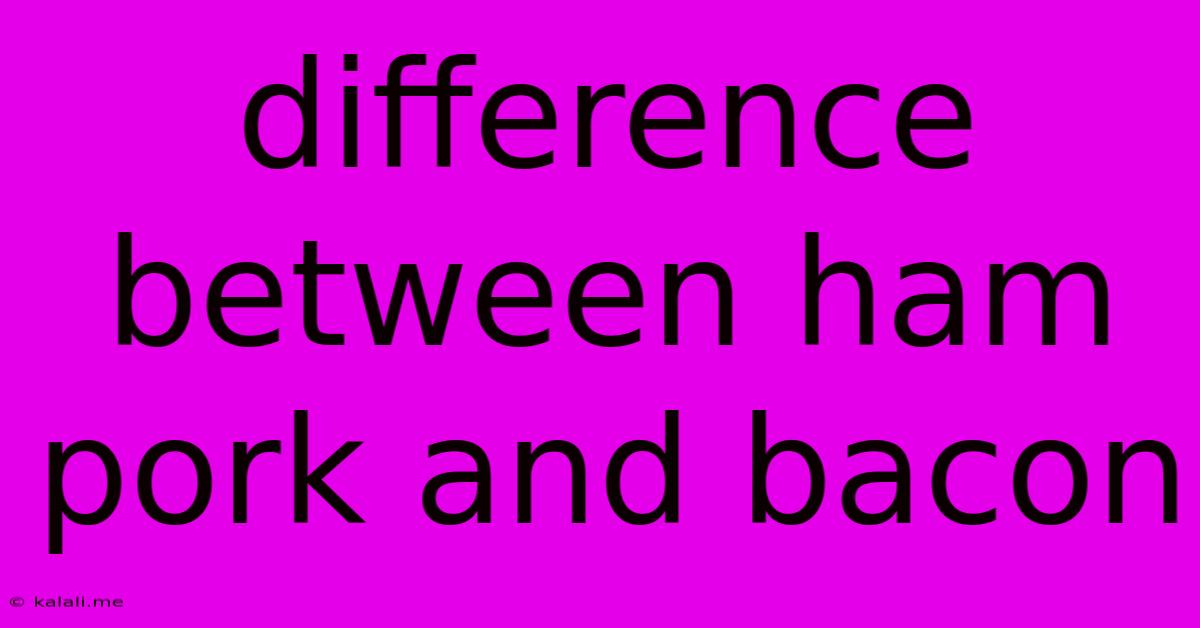Difference Between Ham Pork And Bacon
Kalali
May 21, 2025 · 2 min read

Table of Contents
Ham, Pork, and Bacon: What's the Difference?
This article will explore the differences between ham, pork, and bacon, three popular cured meats often causing confusion. Understanding their distinctions helps you make informed choices at the grocery store and in the kitchen. We'll delve into the curing processes, cuts of meat, and typical uses for each.
What is Pork?
Let's start with the foundation: pork is simply the meat from a domestic pig. It's incredibly versatile, encompassing various cuts used to create ham, bacon, and countless other dishes. Think tenderloin, chops, shoulder, belly – all come from the pig and are considered pork. Pork offers a lean protein source rich in vitamins and minerals, making it a staple in cuisines worldwide.
Understanding Ham
Ham refers to the cured meat from the hind leg (or occasionally the shoulder) of a pig. The curing process is crucial, involving salting, smoking, or a combination of methods. This preservation technique not only enhances flavor but also extends the shelf life. Different curing styles result in various ham types:
- Dry-cured ham: This type undergoes a longer curing process, often involving salt and air drying, resulting in a more intense, salty flavor. Prosciutto is a prime example.
- Wet-cured ham: This method uses a brine solution for curing, resulting in a moister ham with a milder flavor.
- Smoked ham: Many hams are smoked after curing, imparting a smoky aroma and flavor.
Bacon: The Beloved Breakfast Staple
Bacon, a breakfast favorite, is made from cured and smoked pork belly. The belly is the underside of the pig, containing more fat than other cuts. This fat contributes to bacon's characteristic rich, savory flavor and its crispy texture when cooked. The curing process for bacon often involves a combination of salt, sugar, and nitrates or nitrites, followed by smoking. Different smoking methods and curing times yield variations in bacon's flavor profile, from mild to intensely smoky.
Here's a table summarizing the key differences:
| Feature | Pork | Ham | Bacon |
|---|---|---|---|
| Source | Various pig cuts | Pig's hind leg (or shoulder) | Pig's belly |
| Curing | Often not cured | Always cured | Always cured and smoked |
| Fat Content | Varies greatly | Moderate to high | High |
| Flavor | Varies greatly | Salty, savory, smoky | Rich, smoky, savory |
| Typical Use | Roasts, chops, ground pork | Sandwiches, main courses | Breakfast, salads, sides |
Choosing Your Cut:
The best choice depends on your recipe and preference. If you need a lean protein, pork tenderloin is ideal. For a flavorful main course, ham offers versatility. And when craving a rich, crispy treat, bacon remains unmatched. Understanding these differences empowers you to select the perfect pork product for any culinary endeavor.
Latest Posts
Latest Posts
-
Dr Who Crack In The Wall
May 22, 2025
-
Is It You Re Or Your Welcome
May 22, 2025
-
How Long Can You Keep Thawed Chicken In The Fridge
May 22, 2025
-
Imessage Not Working With One Contact
May 22, 2025
-
Is It Haram To Be Friends With The Opposite Gender
May 22, 2025
Related Post
Thank you for visiting our website which covers about Difference Between Ham Pork And Bacon . We hope the information provided has been useful to you. Feel free to contact us if you have any questions or need further assistance. See you next time and don't miss to bookmark.